Plant Foods Highest in Protein per Net Carb
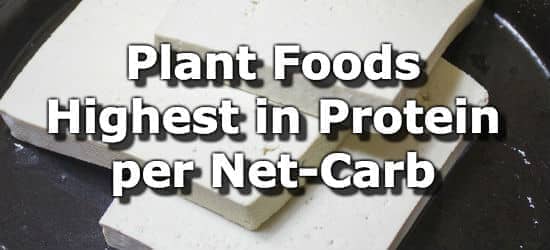
Adopting a plant-based diet is gaining in popularity, not just for ethical reasons, but also for environmental sustainability, and health reasons. (1) At the same time, many people are adopting diets that limit their intake of carbohydrates, such as 'keto' or 'eco-Atkins' diets.
Low-carb diets are typically high in protein, as they often involve relatively high meat consumption. However, those following a low-carb plant-based diet may be concerned about getting enough nutrients, especially protein. There are many great plant sources of protein available that also have low net carbs.
The standard daily value (DV) for protein is 50 grams per day, but you may require more or less depending on your weight and activity level. (2)
The high protein plant foods below are ranked by protein to net carb ratio. High protein plant foods that are low in net-carbs include soy foods, leafy greens, nuts, seeds, and sprouts. For more ideas, see the complete ranking of 200 vegan foods highest in protein per net-carb.
List of High Protein Plant Foods per Net Carbs
-
36g protein per 1g net-carbs
 1. Firm Tofu + Add
1. Firm Tofu + Add
Protein per Cup Protein per 100g 43.5g
(87% DV)17.3g
(35% DV)Note: The amount of protein in tofu can range between 4.8g (10% DV) to 17.3g (35% DV) per 100 gram serving (or a little less than 1/2 cup). See the nutrition comparison of 10 common tofu brands.
To find more, use the detailed nutrient ranking of all vegan foods high in protein.
-
20g protein per 1g net-carbs
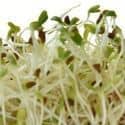 2. Alfalfa Sprouts + Add
2. Alfalfa Sprouts + Add
Protein per Cup Raw Protein per 100g 1.3g
(3% DV)4g
(8% DV) -
12g protein per 1g net-carbs
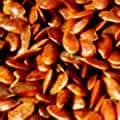 3. Flax Seeds + Add
3. Flax Seeds + Add
Protein per Oz Protein per 100g 5.2g
(10% DV)18.3g
(37% DV) -
8g protein per 1g net-carbs
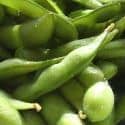 4. Boiled Soybeans (Edamame) + Add
4. Boiled Soybeans (Edamame) + Add
Protein per Cup Protein per 100g 31.3g
(63% DV)18.2g
(36% DV) -
7g protein per 1g net-carbs
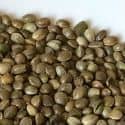 5. Hemp Seeds + Add
5. Hemp Seeds + Add
Protein per Oz Protein per 100g 9g
(18% DV)31.6g
(63% DV) -
4g protein per 1g net-carbs
6. Seeds (Squash and Pumpkin Seeds) + Add
Protein per 1oz Handful Protein per 100g 8.5g
(17% DV)29.8g
(60% DV) -
3g protein per 1g net-carbs
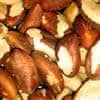 7. Brazil Nuts + Add
7. Brazil Nuts + Add
Protein per 1 Oz Handful Protein per 100g 4.1g
(8% DV)14.3g
(29% DV) -
3g protein per 1g net-carbs
 8. Tempeh + Add
8. Tempeh + Add
Protein per Cup Protein per 100g 33.7g
(67% DV)20.3g
(41% DV) -
2g protein per 1g net-carbs
 9. Almonds + Add
9. Almonds + Add
Protein per 1oz Handful Protein per 100g 6g
(12% DV)21.2g
(42% DV) -
2g protein per 1g net-carbs
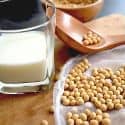 10. Unsweetened Soymilk + Add
10. Unsweetened Soymilk + Add
Protein per 16oz Glass Protein per 100g 14g
(28% DV)2.9g
(6% DV) -
2g protein per 1g net-carbs
 11. Spinach + Add
11. Spinach + Add
Protein per Cup Cooked Protein per 100g 5.3g
(11% DV)3g
(6% DV) -
2g protein per 1g net-carbs
 12. Peanuts (Dry Roasted) + Add
12. Peanuts (Dry Roasted) + Add
Protein per Oz Protein per 100g 6.9g
(14% DV)24.4g
(49% DV)
From the Nutrient Ranking Tool
Use the ranking tool links below to select foods and create your own food list to share or print.
- Foods High in Protein
- Foods Low in Protein
- Vegetables High in Protein
- Fruits High in Protein
- Vegetarian Foods High in Protein
- Nuts High in Protein
- Grains High in Protein
- Beans High in Protein
- Dairy High in Protein
- Breakfast Cereals High in Protein
- Fast Foods High in Protein
View more nutrients with the nutrient ranking tool, or see ratios with the nutrient ratio tool.
Related
Data Sources and References
- Corrin T, Papadopoulos A. A Look at Plant-Based Diets Appetite. 2017 Feb 1;109:40-47. doi: 10.1016/j.appet.2016.11.018. Epub 2016 Nov 18. 27871943
- U.S.FDA - Daily Value on the New Nutrition and Supplement Facts Labels
- U.S. Agricultural Research Service Food Data Central
Simplify Nutrition Tracking with MyFoodData!
Speedy Tools and Detailed Data FREEEasily analyze your meals to find the best foods for your goals.
✅ Use our recipe nutrition calculator and nutrition comparison tool.
✅ Access expert nutrition data tools and in-depth articles.
✅ Log foods and organize your recipes with a free account.


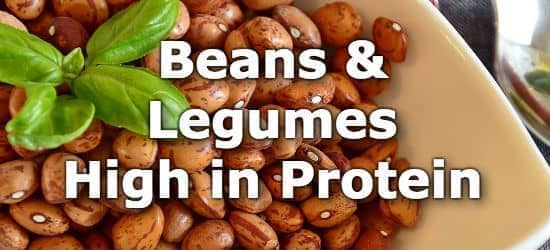 Next ➞
Next ➞
